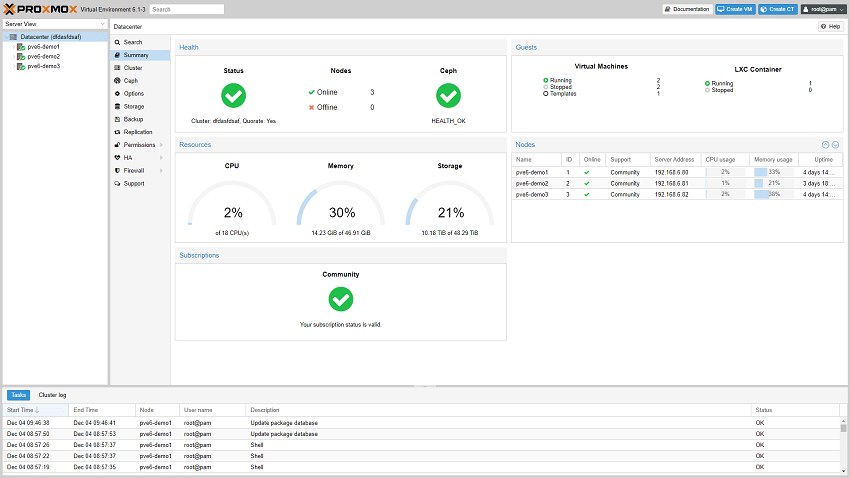Proxmox Server Solutions GmbH has announced version 6.1 of Proxmox VE (PVE), the company’s open-source virtualization management platform. Based on Debian Buster 10.2 and a 5.3 Linux kernel, PVE 6.1 features the latest updates to virtual environment open-source technologies, including QEMU 4.1.1, LXC 3.2, Ceph Nautilus 14.2.4.1, Corosync 3.0, and ZFS 0.8.2. Version 6.1 is also highlighted by new features, better cluster stability, a HA migrate option, bug fixes, and improvements to the web interface. If you’re looking to leverage this platform, read our guide on installing Proxmox VE Hypervisor.

Among the updates to PVE 6.1, the new container features are one of the most welcomed. For example, “pending changes” allows users to make changes to running containers, which will then be applied after the following reboot via the GUI, the API, or the command line interface. Additionally, mount point hot-plugging is now enabled by using the new mount API through Linux Kernel 5.3.
Web interface improvements are also a major highlight of version 6.1. For example, if the package ifupdown2 of the Debian network interface manager is installed, users can now change the network configuration and reload it in the Proxmox web interface without have to reboot. Other improvements include:
- Added configuration options including settings for Universal 2nd Factor (U2F) or editing the cluster-wide bandwidth limit for the traffic types migration, backup/restore, cloning, disk-move are available.
- Improvements to the two-factor authentication allowing to use a hardware-based TOTP key.
- Mobile interface: In the mobile interface a login for TOTP-based two-factor authentication enabled user accounts has been implemented.
- The scale mode of noVNC can be changed in "My Settings".
- A new "Run now" button for cluster-wide backup jobs has been implemented.
Proxmox has added a few SPICE enhancements in the GUI as well: users can add audio devices without having to edit the configuration file, video streaming can be enabled, and sharing folders between the SPICE client and a VM is now possible (though Promox indicates that this is in a experimental phase). Additionally, the SPICE USB device now supports USB3 if users are using Qemu 4.1 or greater.
Here is a rundown of other highlighted changes to PVE 6.1, as indicated by Promox:
- Backup/Restore: VMs with IOThreads enabled can be backed up with Proxmox VE 6.1. Additionally, administrators can run scheduled backup jobs manually from the Datacenter in the GUI.
- Improvements to the HA stack:
- New 'migrate' shutdown policy: If the new migrate option is enabled, running services are migrated to another node on shutdown. As soon as the node comes back and the services were not manually moved to another node in the meantime, the services will move back.
- New 'crm-command stop': Shuts down a VM/container with the specified timeout and performs a hard stop if the timeout is 0. A VM or container stop command will be redirected to this new crm-command.
- For QEMU, the new 'reboot' API call enables to apply pending changes without having to wait for the guest to shutdown before starting it again. In Proxmox VE 6.1, PCI(e) passthrough now supports up to 16 PCI(e) devices.
- Virtual guests can enable 'tags' in the guest configuration. This meta-information is very useful for configuration management with Ansible, Puppet, SaltStack, etc..
- Software-defined Storage: In the Proxmox storage backend, all features offered by newer kernels with Ceph and KRBD are supported with version 6.1. For storing raw disk images, the .img file format is additionally allowed as an alternative to ISO images (.iso). The configuration of non-default 'mountpoint' properties for ZFS are allowed.
- Improved certificate handling including compatibility for latest browsers. The lifetime of newly generated certificates has been reduced from ten to two years.
- Firewall: Added support for 'raw' tables and use them to allow users to enable and configure Synflood-Attack protections.
Availability
Proxmox VE 6.1 is available for download now.




 Amazon
Amazon